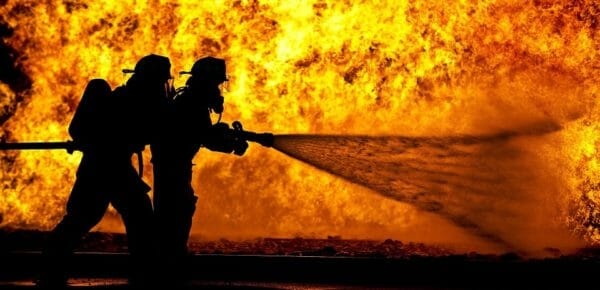We are sure you have been there before. The heat hits your hand, and you are now burned by fire. Ouch! Anyone and everyone who has ever been burnt by fire will tell you that heat is not something to mess with and should be respected. Burns can be one of the most painful types of injuries out there. This is because they do not heal very quickly and can be insanely painful. In many cases, they also can be difficult to keep clean and maintain a clean wound while it heals. This is where the difference between flame resistant vs flame retardant comes into play.
With burns, they usually originate from fire. In the right or wrong circumstances, fire can be very dangerous, and it has created many products and companies to have very strict regulations and rules in place to limit the risks of fire in our society.
Many occupations deal with flame related injuries often, even if you do not realize it. For example, many who work in the oil, gas, iron, and welding industries experience many burn-related injuries. The amount of people that receive medical treatments for burns can be shocking, reporting almost 500 thousand people in 2016 by the American Burn Association.
Fire safety
Everyone learned the basics of how to put out a fire in elementary school. The three words stop, drop, and roll should come to mind as the recommendation if you are on fire. But that is what to do if you are already on fire. What about avoiding the fire all together?
There actually is a way to avoid fire, and it is not just avoiding it or other hot things that can cause a fire! Flame resistant and flame retardant clothing and products do exist. These are the best fireproofing methods and can potentially prevent fire all together. But what is the difference between flame resistant vs flame retardant? How do they work? Is one better than the other? Let’s take a closer look at the two types of fireproofing.
Fire retardant, fire resistant, and flame resistant are often used interchangeably. Still, there are actually a lot of differences between these words, and their meanings can play a big role in selecting the correct protection from flames. It is important to know the differences between the proper protective coatings and sprays, especially in dangerous jobs like welding and oil and gas.
Fire resistance or something called fire-resistance rating is most commonly known by the International Building Code’s definition. This definition basically is a component or assembly that keeps the ability to contain a fire, continues to act as a given structural function, or both, which is determined by the methods or tests. The difference between fire resistant and fire retardant paints is that paints or coatings that are fire resistant are always ensured to comply with these performance specifications that can play a role in the fire resistance rating.
Flame resistant materials
First, flame resistant clothing is produced from certain fabrics that are naturally more resistant to catching on fire. This basically means that the flame resistant material naturally deters fire more than other materials. Unfortunately, these days, a lot of clothing lines use mixed materials to produce their fabrics, so you have to be very careful when buying for fire or flame resistant material.
Materials that are flame resistant can catch fire if they are exposed directly to a flame, but the trick is that they are unlikely to catch on fire from just being near a flame. Another reason that makes fire or flame resistant fabric special is that if it does catch on fire, it will have a hard time staying on fire. A lot of flame resistant materials cause fire to extinguish as it basically suffocates the fire.
Some flame resistant fabrics include coated nylon, wool, and leather so you will see a lot of professions that require work with flame have these fabrics integrated in their clothing. Some other flame resistant materials include carbon foam, concrete, glass, gypsum boards, and cement. A simple way to tell if a building is being built for residential purposes is to see if they are using concrete in between units as it is a very flame resistant material.
Flame or fire resistant chemicals are not toxic because they are natural materials that are simply more resistant to fire than others. It is different from flame retardant coating because it is just the material that is naturally more resistant to fire.
Flame retardant materials
On the other hand, we have fire retardant materials. Fire retardant clothing is made up of just about any material that you can think of. There are no types of flame retardants. While that can sound a little weird, fire retardant does not necessarily mean a specific material, even fire retardant spray for wood. It means that the item that we are referencing is coated in a specific chemical spray that is designed to limit a fire’s impact on an object and sustain the flame.
Fire retardant coating or fire retardant chemicals are not as common as they once were because many of them have toxic chemicals mixed in the formula. Fire retardant chemicals can create a toxic flame which is even worse than regular fire. Fire retardant chemicals are often used on furniture or plastics to help prevent fire from spreading. Another benefit of flame resistant coating is that it can also evolve to provide stain prevention features.
Flame retardant and flame resistant clothing
Flame resistant and flame retardant clothing and fabrics can play an important role in many industries. A lot of industries use or work with fire, so it is important to have the correct protective materials and know the difference. From furniture manufacturing industries to oil and gas industries, fire resistant and flame retardant fabrics play a significant role. Not knowing the correct difference between the two can be crucial to safety in high profile industries.
Safety gear has different kinds of materials to make it useful for different things. Fire resistant and fire retardant safety shirts, vests, gloves, and other pieces of clothing are all examples of safety gear that have been treated or created to supply users with an added layer of protection from fire. Fire retardant or flame resistant clothing can be a lot safer than clothing that does not have the protective coatings, but it is not supposed to be exposed to heat for a long amount of time.
Flame resistant vs flame retardant, what is best?
While both flame resistant vs flame retardant methods both have their moment in safety apparel and make an impact on other industries, flame resistance is probably considered much safer than flame retardant coating alternatives. The toxic chemicals that can be found in flame retardant coatings and paint bring up a lot of discussions, and the general consensus is that flame resistant materials are generally a lot safer since they are more natural materials. Toxic chemicals that come from flame retardant materials can have a negative impact on our health and even our ecosystem.
While both methods of flame resistant vs flame retardant are great, the very best solution to fire safety is to be careful and try to avoid it whenever possible in uncontrolled and unsafe environments. Even in a very safe environment, fires can be extremely dangerous and should always be closely monitored. Flame retardant and flame resistant clothing are only designed to prevent possible injury and keep you safe until you can move to a safe location. It doesn’t mean that you can handle a fire!
Now you know the difference between flame resistant vs flame retardant, so you can make the correct choices when it comes to fire safety.



